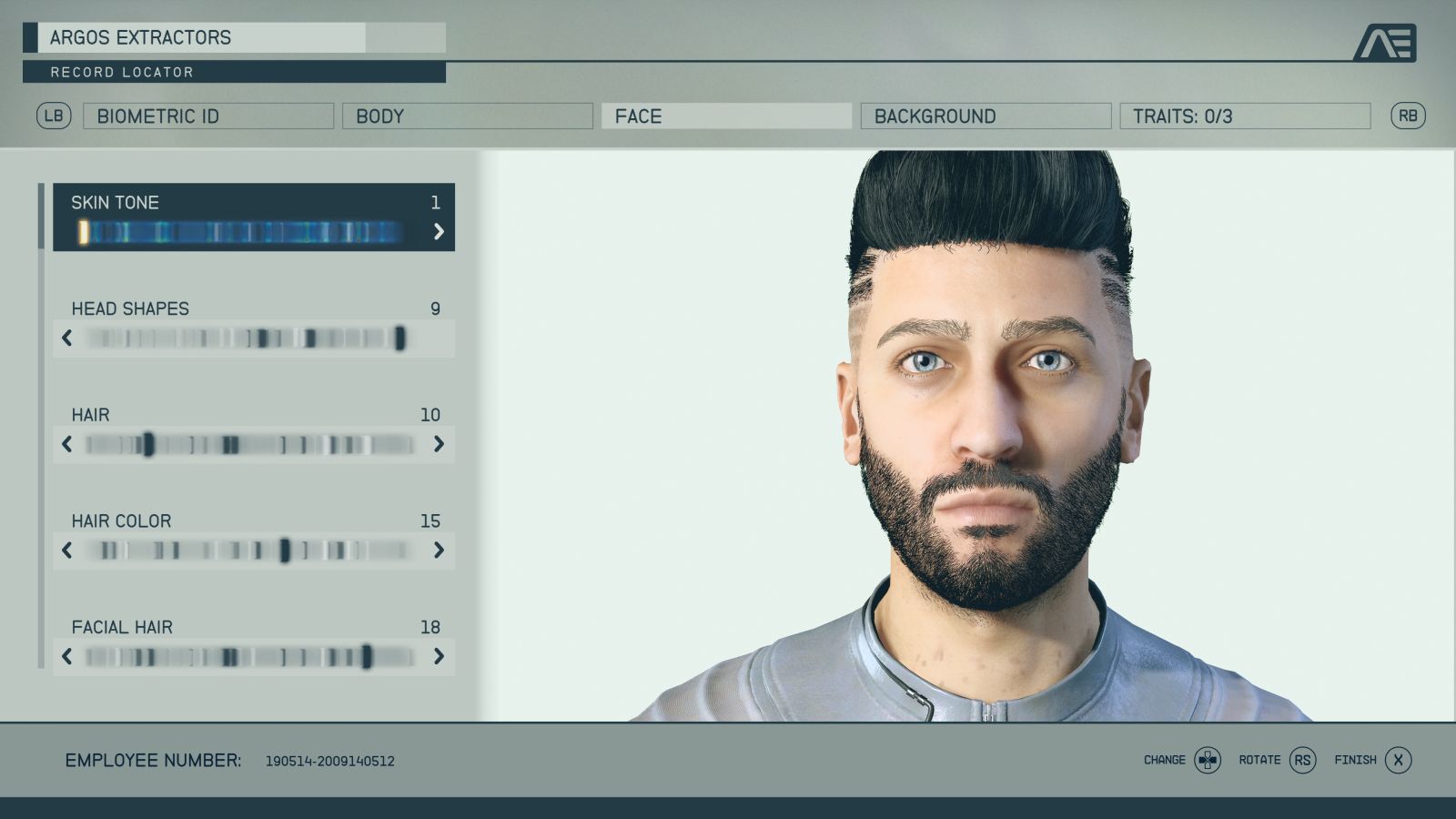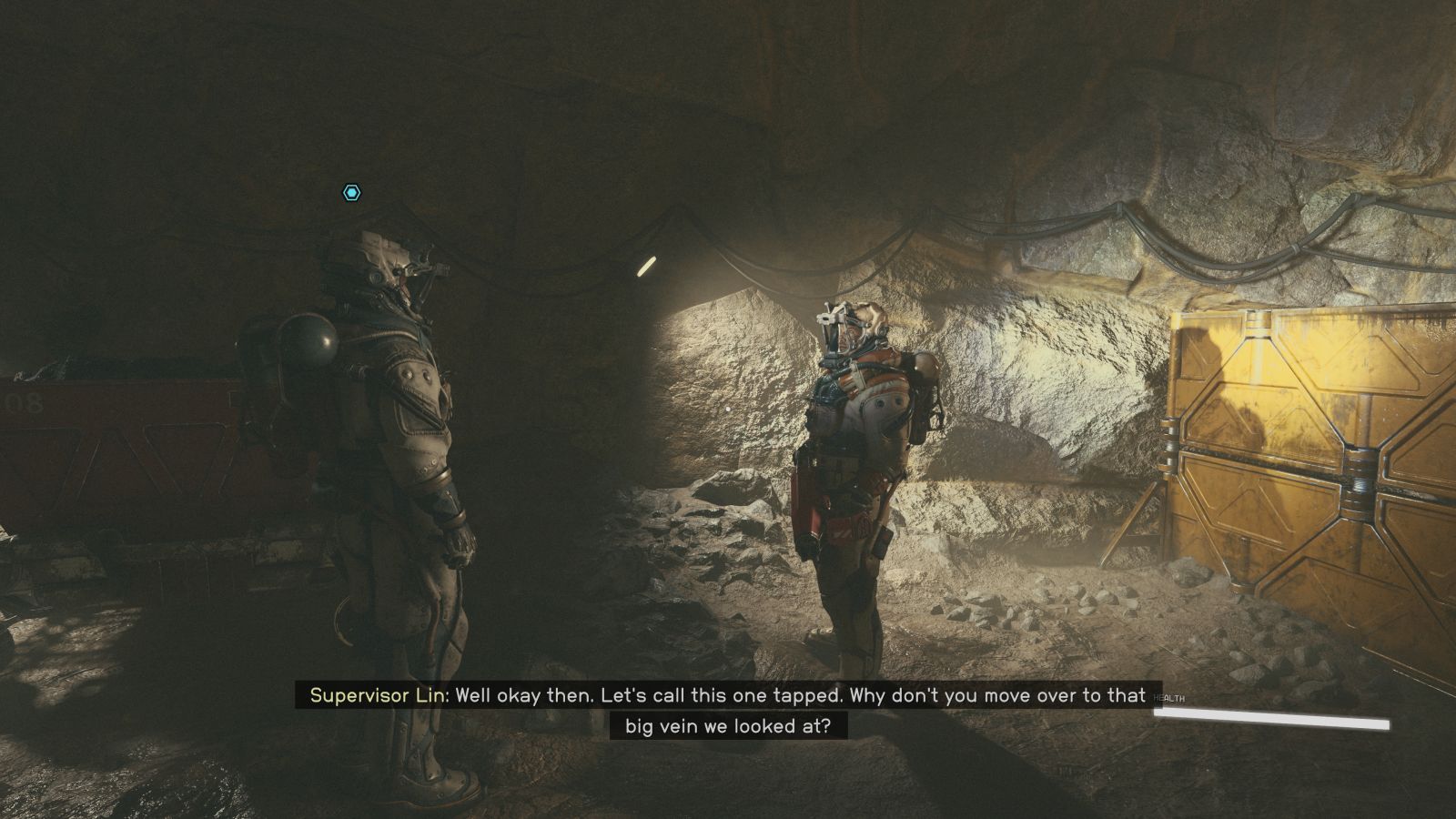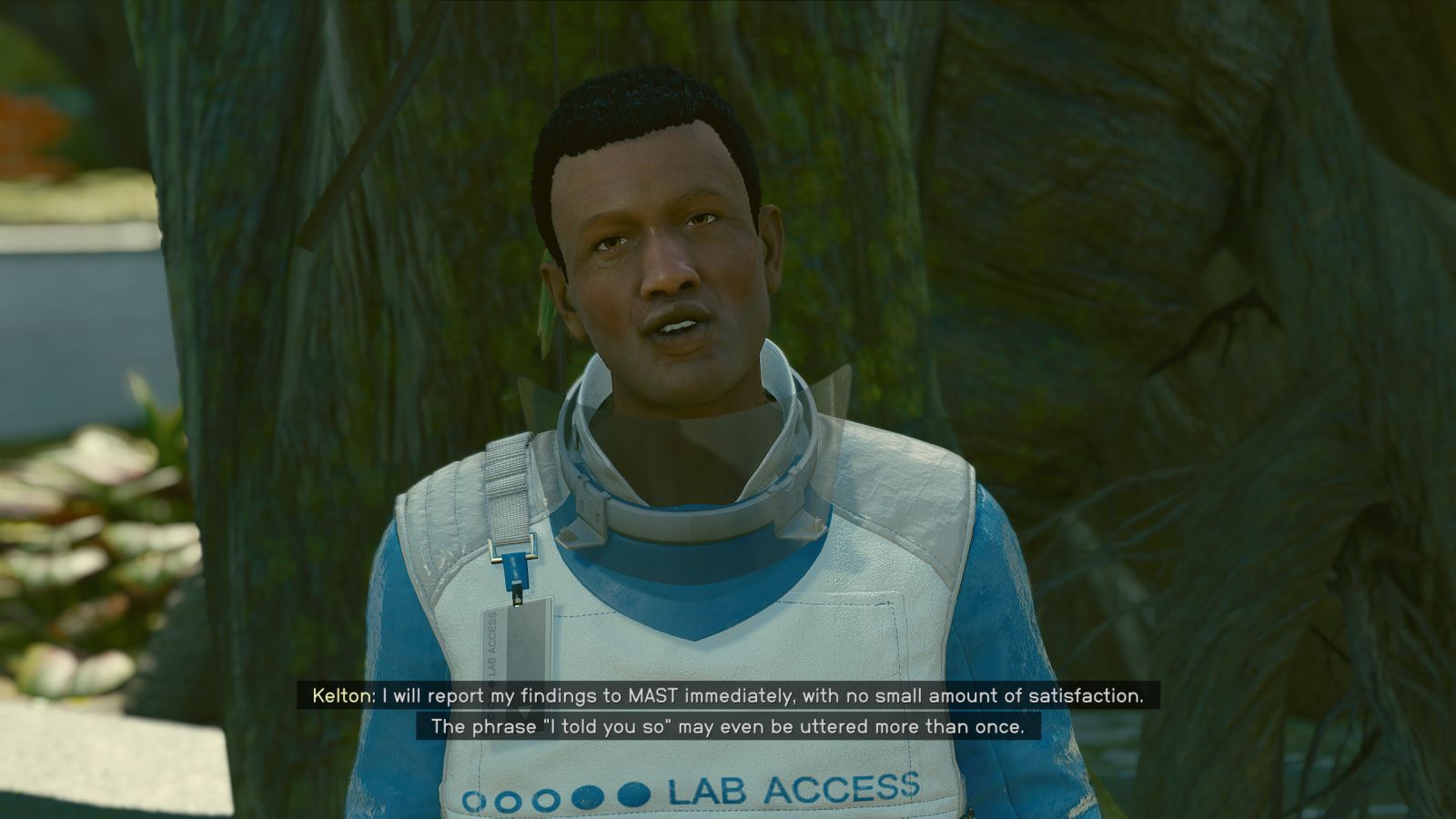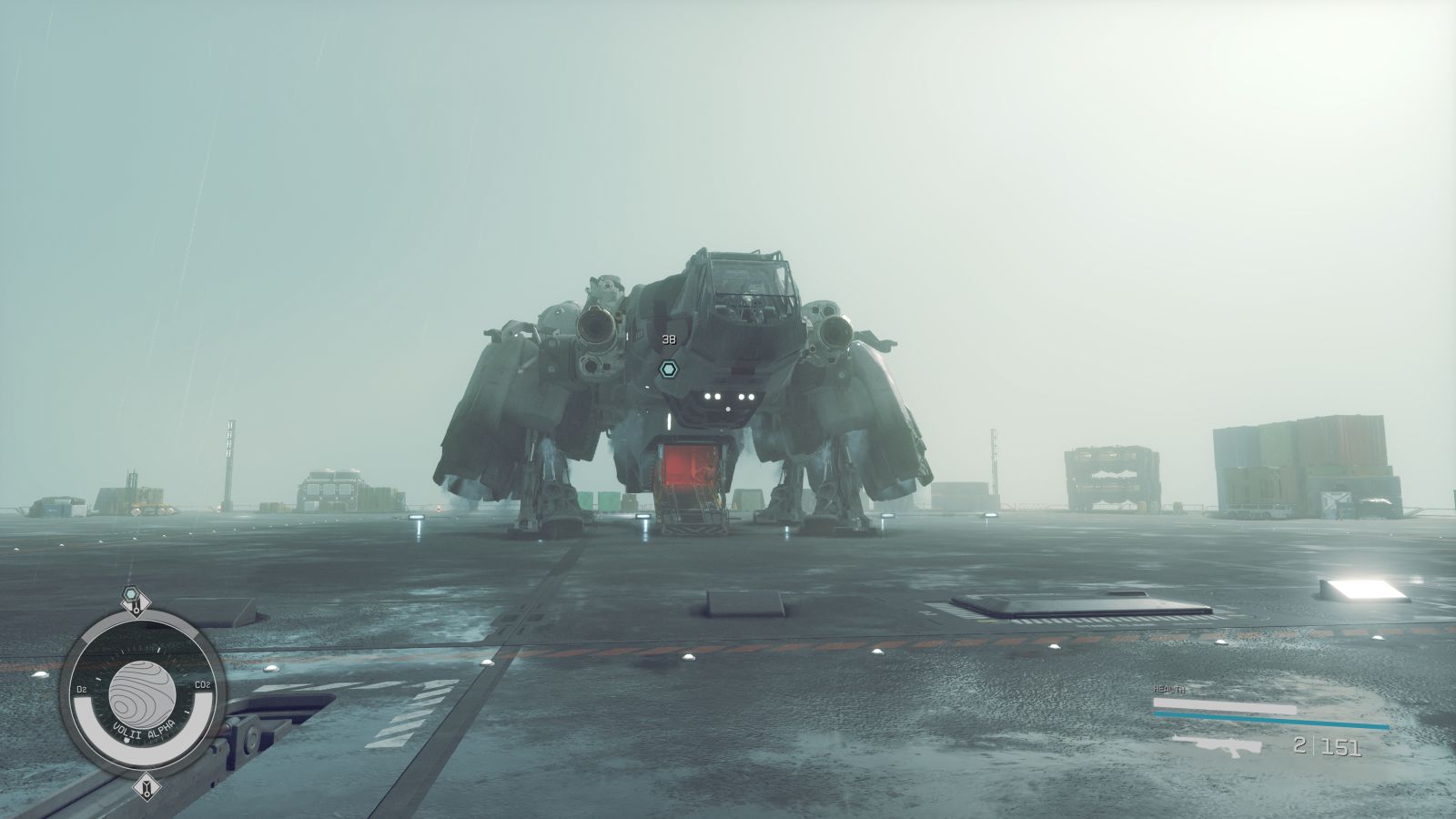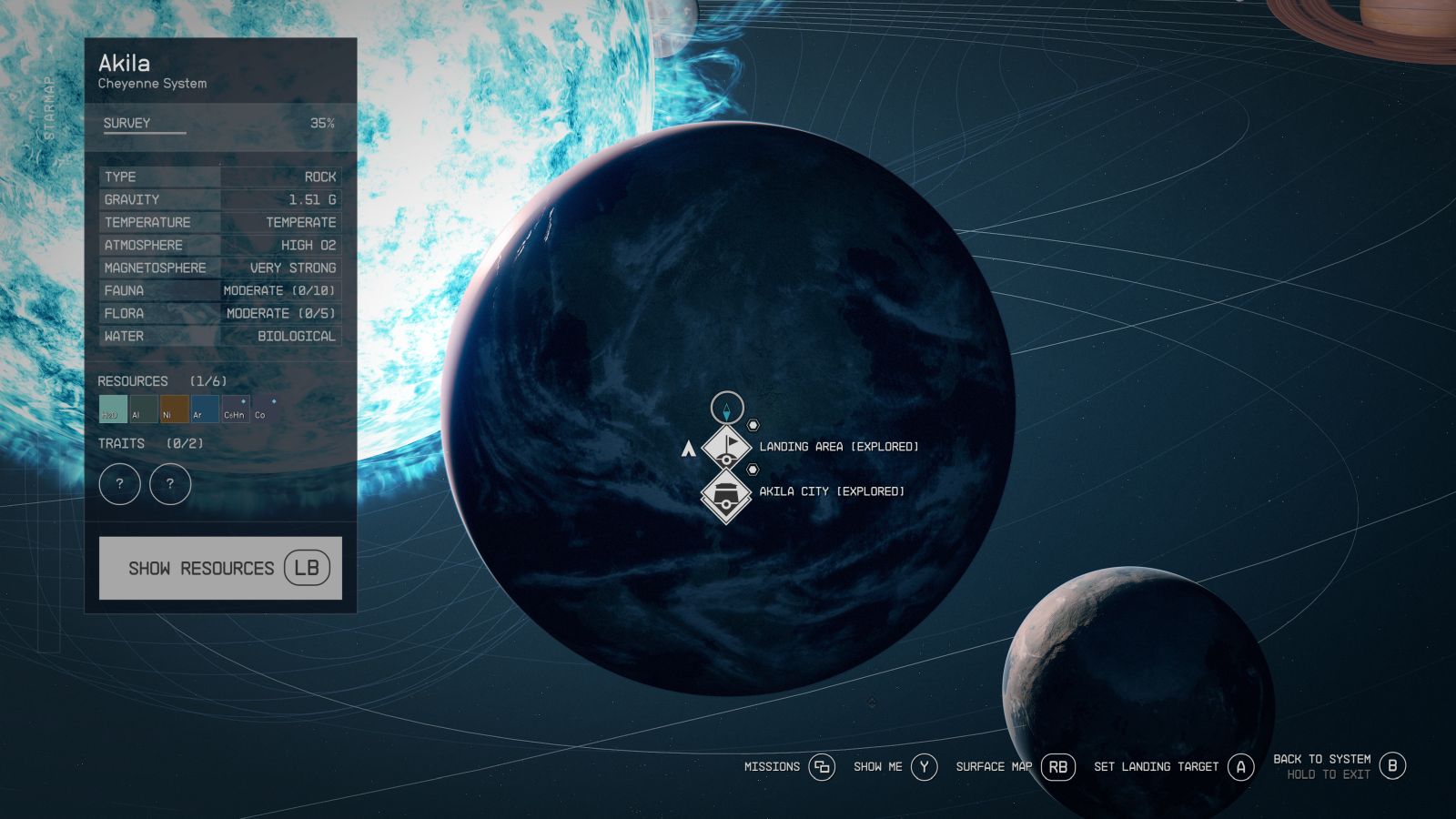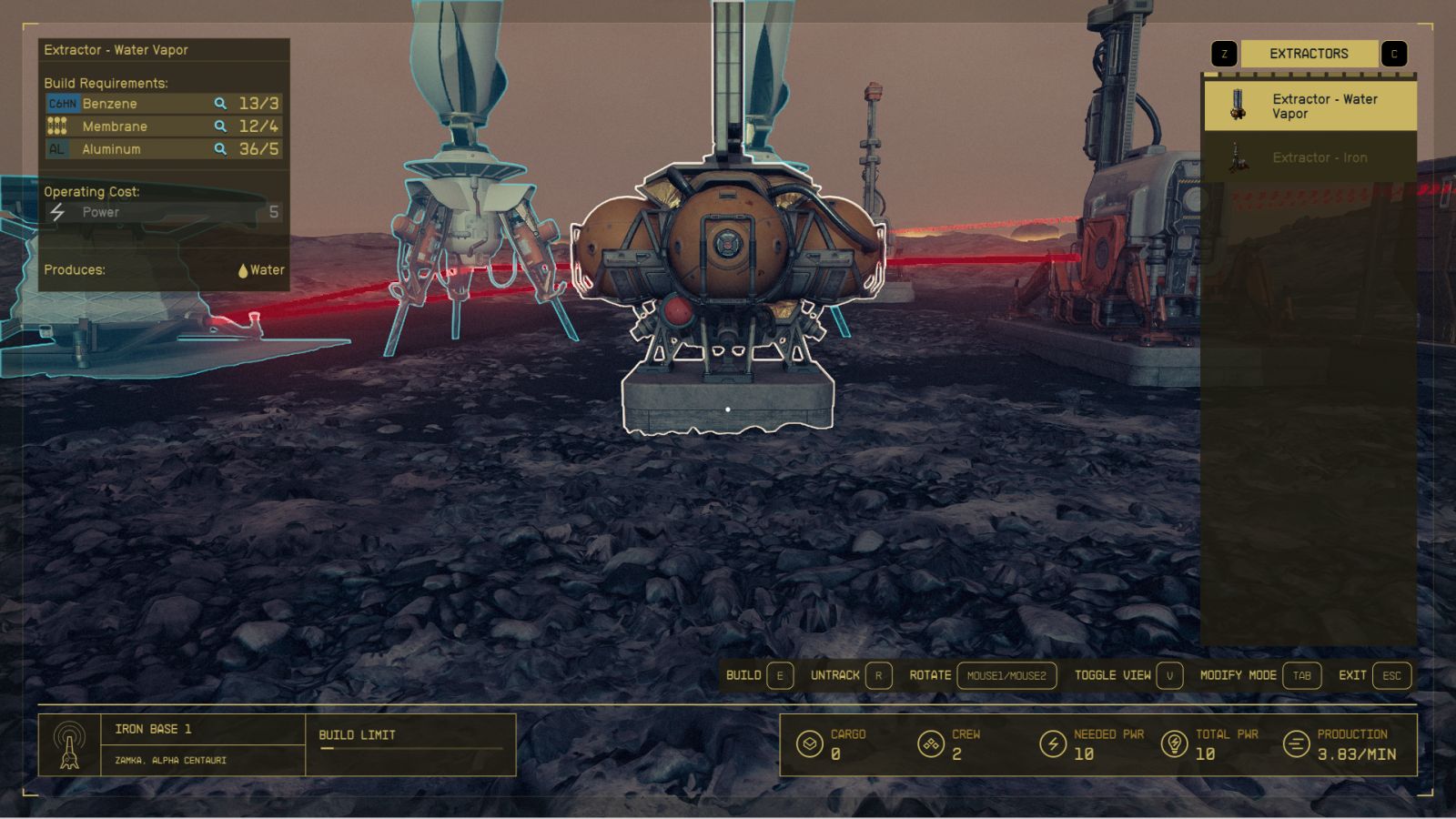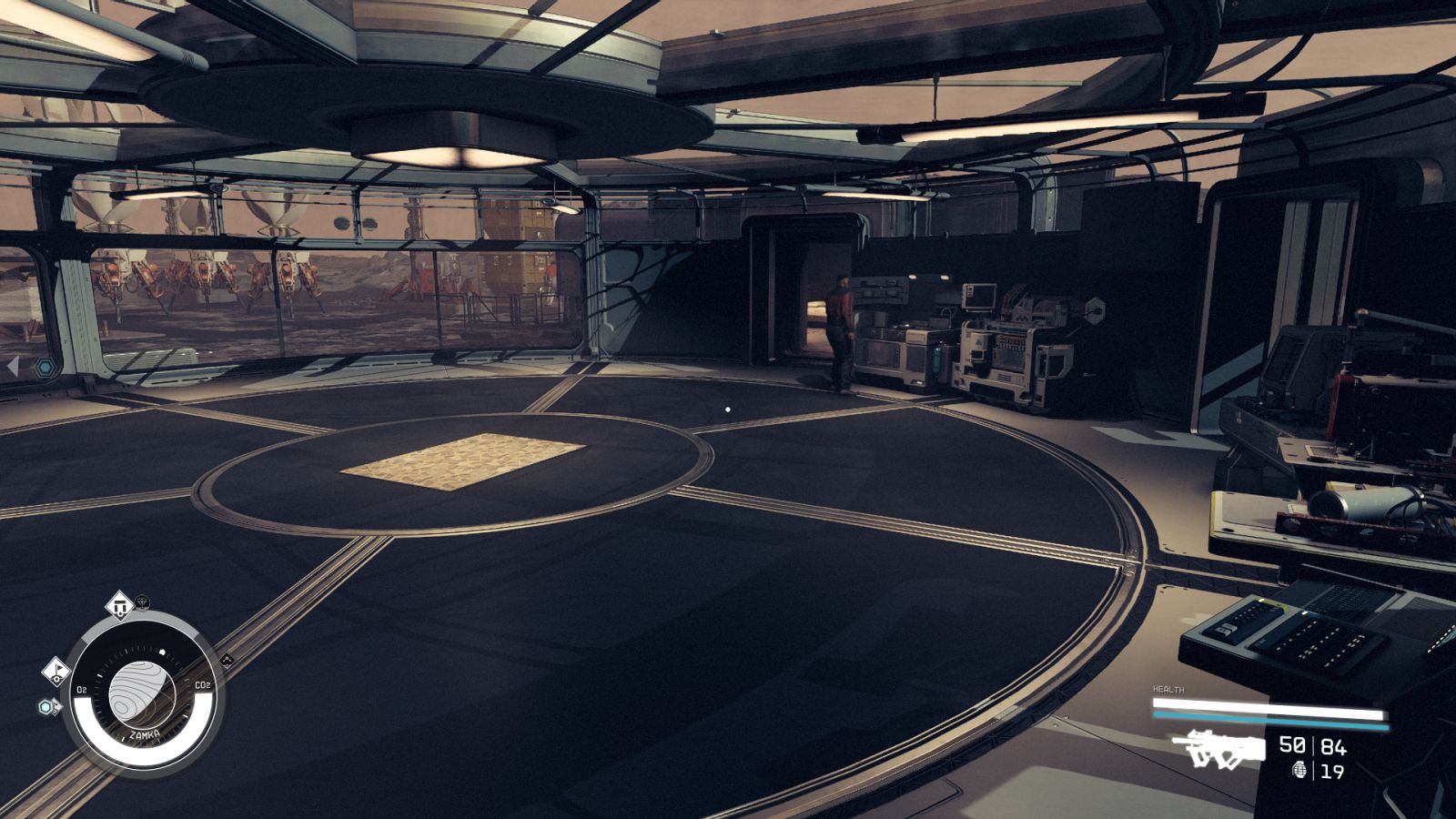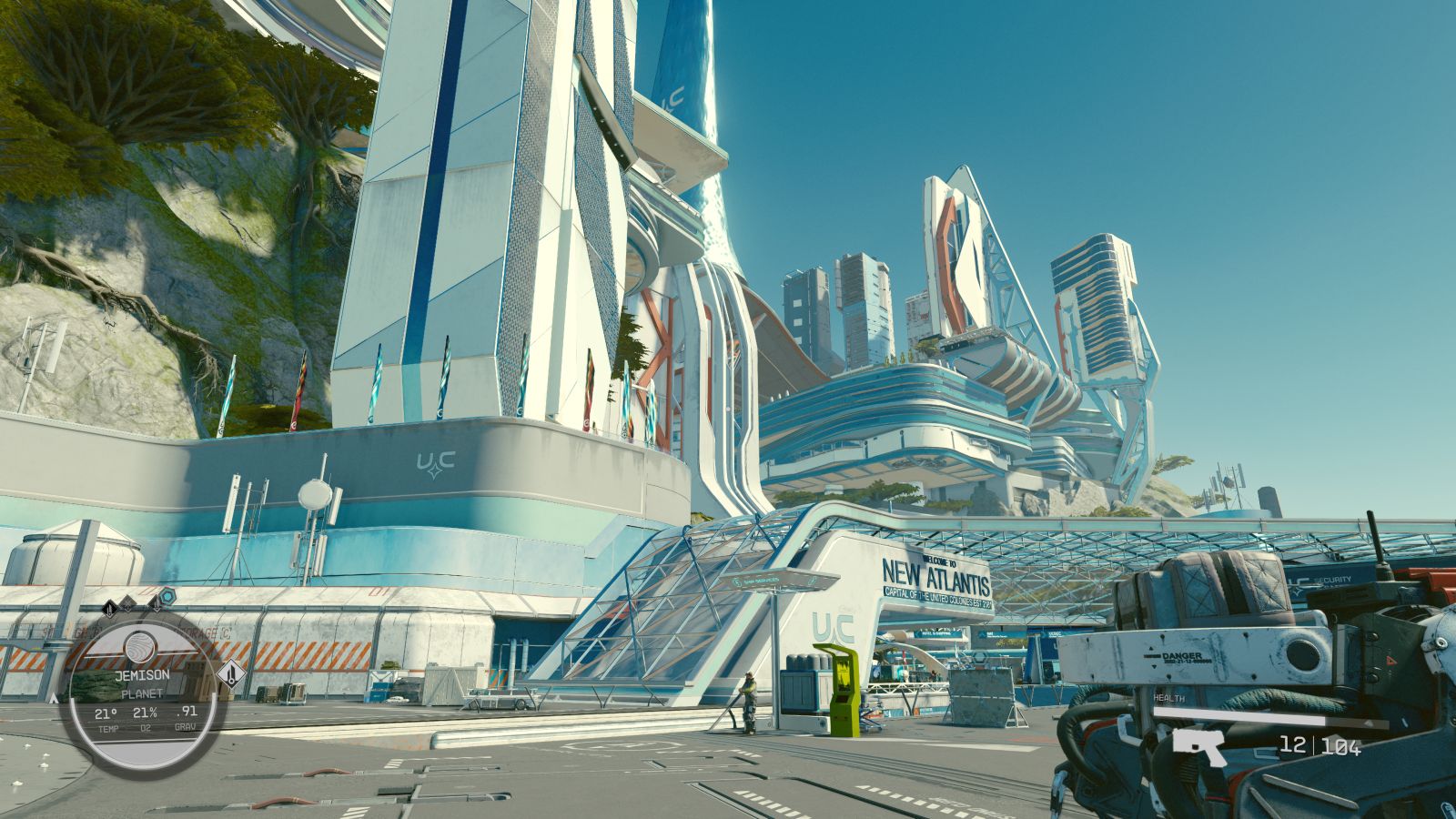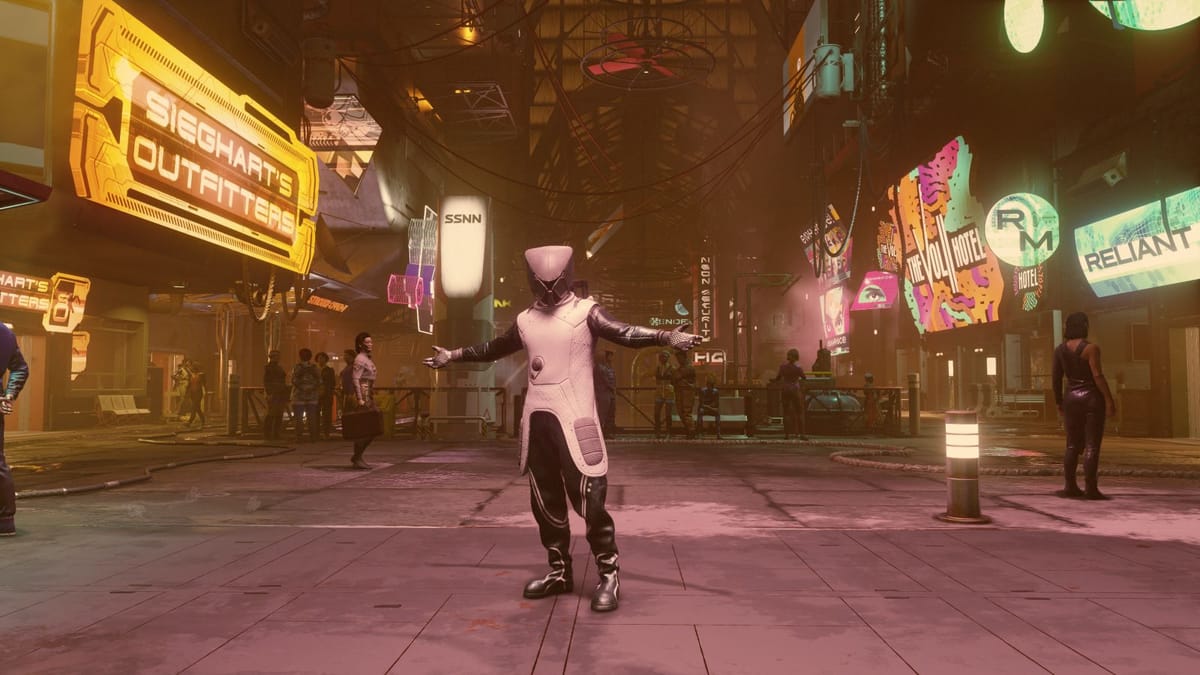
I’m a huge fan of Bethesda games because of the freedom and worldbuilding they offer. When you throw in a sci-fi theme, Starfield is a dream game for me, and it’s absolutely massive. That said, how in the world do you review a game like this; one so big you can’t possibly cover every aspect of it? Well, that’s what the crew here at GamingTrend is attempting to do, without spoiling anything for you, and that can only be accomplished one planet at a time.
Everything begins a bit differently in Starfield and, surprisingly, you don’t start in a prison. Instead, you start as a space miner out in the cosmos. You’re going about the gig, doing mining things, and in a newly unearthed cavern, you’re sent ahead. Coming upon an interesting piece of shiny metal debris, you use your trusty cutter to pull it out. Suddenly, visions of light and music flood your brain, knocking you unconscious. After coming to and answering a few questions in the form of the character creator, a new arrival changes the landscape of your existence.
Speaking of the character creator, we’re back to sliders in Starfield over Fallout 4’s drag and morph system, making it much easier to make something that looks like a person. There are a ton of options here, complete with scars, freckles, makeup, and of course more hairstyles than you can shake a stick at. You can choose your body type, walk style, and pronouns (She/Her, He/Him, They/Them) separately too. Once you’ve made your masterpiece (you can change certain aspects later, so no need to obsess), you choose your background and traits.
Backgrounds give you three starting Perks and occasional dialogue options relating to them. For example, the Long Hauler background gives you the first levels of Weight Lifting, Piloting, and Ballistic Weapon Systems, and you’ll also be able to relay these skills to long and hard jobs. It doesn’t come up too often, but it certainly helps with roleplaying, which combined with our next topic makes this one of the best Bethesda games to do this.
Next up are Traits, of which you can pick up to three, or none at all if you wish. These can affect your playthrough in super interesting ways. Taking Empath will give you bonuses when being nice and making others feel good, while being mean and making others feel bad gives you a debuff – just like in real life! This will also give you some incredibly helpful dialogue options, like being able to intuit that an ambush is waiting for you because a guard is giving off weird vibes. Another example is Hero Worshipped, which allows you to immediately regret your decisions by giving you an Adoring Fan who will follow you around everywhere. However, you can assign him to a settlement if you get sick of him and want to make him more useful. There are seventeen traits that can make each playthrough unique, and we’re excited to go back and see what they all do. For now though, we’re back to the intro sequence.
Starfield shifts between slow and fast, tossing you against a fray of space pirates who are pursuing Barrett, the explorer who just walked off his ship, but also providing little in the way of direction beyond that. Once you’ve defeated them, it’s time to take your knowledge of this Artifact to Constellation, an explorer’s society dedicated to answering just what these pieces of metal are. Barrett hands you the keys to the Frontier, your first spaceship, and stays in your place to allow your passage to Jemison, the planet on which New Atlantis and Constellation’s headquarters of The Lodge lie.
Where things are slow, however, is more in the reveals that arrive. You don’t get many tutorials, leaving you to figure out how Bethesda has decided to lead you into the different gameplay systems. Beyond that, the story starts off quite vague, similarly holding back their revelations until later. I never had a “vault opening” or “Alduin attacking” moment at the beginning of Starfield, and you feel that throughout the first few hours of the game. There’s no punch in how it starts, being much more obtuse compared to recent Bethesda titles.
That being said, once you get past the slow intro, Starfield is peak Bethesda gaming. Simply walking from one mission to another will result in multiple side quests popping up along the way. If you’re OCD, you probably deserve an apology from Todd Howard, because there is no way you’re going to be able to have one quest at a time. It’s a testament to the team in how much they’ve sunk into Starfield, because it’s not just that there’s a bunch to do, but nearly all of it is interesting.
For example, I was walking towards The Lodge and heard someone talking about a scientist who looked sad. A quest popped in, and I went over to figure out what was going on. Turns out, there was an issue with a specific tree, and according to the scientist there could be violent ramifications. The ensuing missions separated into three parts, with each one having a different goal. There was everything from deleting files from someone’s personnel records to taking a tree branch from a museum, and each moment of it felt alive and fully realized.
In another section of the game, I decided to pay off one of my accrued fines at the United Colonies offices (one of the in-game factions), only to be told I had to come with them. Before I knew it, I was aboard a spaceship in an interrogation chamber, being roped into an undercover mission to infiltrate space pirates. If that doesn’t speak to Bethesda absolutely knocking role-playing out of the park, I don’t know what will. Bethesda builds a world you truly live in and feel a part of, something not many other games manage to capture. And to think, my examples all occurred in the first fifteen to twenty hours of Starfield, while trying my hardest to follow just the main story, with so much more to come afterwards.
What’s even more impressive are the characters Bethesda has behind these quests. Nearly all of them have had intricate narratives woven into them, all of them fully voiced, giving you a sense of life behind their digital eyes. This also extends to any character you can interact via dialogue with, and the depth of the named NPCs is truly incredible. Character design is miles ahead of previous Bethesda games, with well crafted models that feel more real and less plastic. That doesn’t mean you don’t get occasional stiffness; the emotional element is still somewhat missing in facial animations, but given there are hundreds of these characters, it’s easy to hand out a pass here with how well everything else is done. Also, kudos to bringing in some great voice actors. Even the more basic named NPCs you’ll encounter deliver superb lines.
Initially your companions might not seem like much, but adventure with them for a bit and they’ll open up to you with their own quests, feelings, and stories. For example, Sam Coe comes off like a loner at first, but adding him to your ship crew will have his daughter Cora come along for the ride. If you take a minute to talk with them, you’ll learn that Sam used to be a Freestar Ranger alongside his ex-wife, and Cora loves to read books, both fiction and non-fiction. As you build a relationship, Sam will approach you with quests every so often until, eventually you hit a big turning point in his life and can choose to date then marry him or just stay friends. (Marriage will commit you to that specific relationship, while dating does not.) Most companions follow this same structure, and it’s a lot of fun getting to know them all. They may carry your stuff when you hit the weight limit, but take a minute to speak to them and you’ll find hidden depths.
And that’s a great segue into dialogue. Gone are the vague Fallout 4 three word choices, and back are the fleshed out sentences. You know what you’re about to say to someone, and it feels right. Not only that, but when you have speech options based on your skills (more on those later), you’ll get a prompt in front of your dialogue choice, such as “[Persuade]”. This lets you know exactly what you’re doing, and that’s such an important factor in building an enjoyable dialogue system. Plus, there’s just so much lore and story dumped into the dialogue. Bethesda has usually done a fantastic job in this area, and this is the best they’ve ever crafted. I also love being able to completely avoid a boss fight with dialogue. Thank you for that Bethesda.
When words don’t work, you’re going to have to use weaponry, and that takes many forms in Starfield. As with most Bethesda titles, sometimes you’ll run in and just punch someone. Other times it’s a melee weapon or a gun. Whatever you choose, Starfield won’t push you in a specific direction, which is how you want things to be. Sure, there are better ways to engage certain enemies – a guy with a shotgun is easier taken out with a sniper rifle than with a knife – but you do you.
Combat is probably most akin to Fallout in how you’ll approach it both in feel and design. I think Starfield is certainly more polished than Fallout 4 was, but doesn’t reach the heights of other first-person shooters. There’s a bit of floatiness in the aiming and it will take a moment to get used to, at least on a controller. A mouse and keyboard feels tighter, of course. Most will look at the Starfield Direct (found below) with the player jetpacking and sliding around as a baseline, but that’s not how you’ll most likely approach every encounter, although both are fun to utilize. Most of the time it’s going to be methodical, and that’s mainly because of how easy you are to take out when multiple enemies are around you (especially before you find better weapons). Overall, this is still a step up from both Skyrim and Fallout, so most will be quite happy with the refined mechanics.
There are no initial stats like skill points or the S.P.E.C.I.A.L system, so your gear (consisting of spacesuits, space helmets, and boost packs) will determine a lot of things like damage resistance or give you bonuses like energy shielding or more carry capacity. These small boosts in stats aren’t terribly interesting, instead you can mod cooler stuff onto your gear at workbenches, provided you have the perks and research. You can have your boost pack make you invisible or your sniper rifle fire acid rounds to pierce through armor. It’s not quite as modular as Fallout 4’s weapons, you can’t reuse a silencer on another weapon for example, but it makes your arsenal more interesting and customizable.
Of course, to get the most out of how you’re doing what you’re doing, you’ll have to level up, and your playstyle will inform what perks you choose. Perks are divided into trees like Science, Tech, and Physical, with points put into each tree eventually unlocking the next tier, but not directly. You’ll have to perform some basic things before you can unlock the next tier. These can be as simple as landing 10 stealth kills, or using the jetpack in combat, but it prevents you from simply spamming points in a single area to suddenly grant yourself a ton of skills.
Perks not only give you bonuses to stuff like damage and carry weight, but also unlock certain features like pickpocketing, the stealth meter, and even boost packs. It’s a bit strange that key things are locked behind perks (we’ll get into that later), but perks do feel much more substantial here than Skyrim or Fallout 4. A single perk point matters much more, so you need to spend them wisely. One point in piloting might let you use an entirely new ship, while something more geared towards settlements could finally get you that weapon upgrade tier you’ve been trying to research. It’s an engaging system with big ripple effects from a single choice.
Even with the system working well, it’s still a bit frustrating. As mentioned before, things like pickpocketing are locked behind the “paywall” (or Perkwall), but I can still lockpick novice locks without as much as looking at the perk chart. Worse still, why can I acquire a boost pack, a basic piece of equipment, but I can’t use it until I pop that skill token in the perk vending machine? There are odd choices here, and they don’t work to the player’s benefit. I do like the challenge idea in theory – that you have to earn your way to the next rank of perk – but I’m not thrilled that I still have to use a perk point to unlock the next rank. It seems somewhat arbitrary, kind of like the two systems of Elder Scrolls skills and Fallout perks were smashed together. Everything works, but it doesn’t land correctly.
With land in mind, there’s a whole lot of galaxy to explore, and whatever planet you’re on has a lot to it. When I say that, I’m not talking about just story elements or cities, but research, resources – all of the things Starfield has to offer. We’ll cover all of the fun settlement, outpost, and mining things later on, but suffice to say each planet has a lot to give you in some shape or fashion. The towering skyscrapers of New Atlantis, the dingy cyberpunk feel of Neon, the dusty, cowboy-filled Akila City; all of these cities show the range of what Starfield can provide.
Sadly, you won’t be able to explore every nook and cranny as there are landing areas with boundaries. You also won’t be able to walk to a city from a random landing spot on the planet, but it doesn’t suck the fun out of exploration. It’s just a glum reminder of the restrictions of different hardware. All of these planets are designed incredibly with their own look and feel, brimming with their own form of existence. There’s absolutely no way I could describe many of them, with so much involved in their making, but Bethesda has once again outdone themselves in creating so much for us to discover. One could argue there’s too much to uncover, but when it’s this good that’s not a bad problem to have.
After stomping around on the ground, it’s time to head to the skies… er, space. Your ship is your lifeblood in Starfield. It’s how you traverse the blackest sea, where your companions hang out when not traveling with you, and of course where you store your junk. The Frontier is an OK starter ship, but eventually you’ll have a fleet of vessels at your disposal. It takes a lot of cash and perks, but you can customize ships or build your own too.
The Ship builder is a bit cumbersome, at least with a controller, with some parts moving around wildly or getting lost in the shuffle, but it’s well worth engaging with to build something suited to different types of missions. A mouse and keyboard offers a few more buttons to press to manipulate the pieces, making it far easier to construct the monstrosity of your dreams, but you can get there with the controller, albeit with a bit more frustration. The way you put everything together is actually very reminiscent of the Gummi Ship from Kingdom Hearts of all things, but much more in depth.
If you want more cargo space, you can build a long hauler with tons of storage, but low maneuverability. For something more nimble, you can make a smaller ship with great weapons and agility, but itty bitty living space. You can’t build an All-in-One ship unless you are loaded with credits, but the specialized method is a lot more fun than a one size fits all. There are also ship crew hanging out around in the places you’ll visit, bringing an extra boost via perks they have. It’s not something you have to do, but it’s a nice bonus to those who spend a lot of time perusing the cosmos.
Your ship isn’t just how you get around the galaxy, however, it also determines where you can go. A ship with a lower class of grav drive won’t be able to skip many systems in a single jump. You’ll also need to stop in a system at least once before you can skip past it, incentivizing you to go out and explore. You might come across an abandoned, zero-gravity casino, a planet with rare materials, or even more quests. There’s so much to see and do here, with some of our favorite stories coming from random events around the galaxy. There’s the grandma who wants to share a meal with you, a school ship that needs fuel, and that one guy who’s just trying to tell you about your ship’s extended warranty.
There’s a lot to see and do both in space and on each planet, but it can feel like you’re not really flying your ship at times. In the sea of stars, you do fly around manually and engage in dog fights, which can be hit or miss depending on your ship and how many crafts you’re going up against, but a lot of your exploring is just fast travel. It does feel surprisingly good thanks to the retro UI and the clack of a keyboard to go along with it, but it’s still frustrating. You definitely need an SSD for Starfield, because you use fast travel almost constantly.
Want to visit another planet? Fast travel. Another system? Fast travel. Even just land on a planet? You guessed it, fast travel. It really is a shame you can’t fly around planets (or even from one to another in the same vicinity), because that would have been incredibly cool. Even without proper flight, planet traversal really could use some sort of vehicle just to get around faster. If you land on one pole and want to get to the next without fast travel, you’re hoofing it. There’s already mechs you can find scattered around, let us use them Todd!
While you might spend half the story fast traveling to different planets, you’re going to be glad you did. We talked about it before; everything starts really slow, but once it ramps up you’ll be mind-blown by where it’s taking you. The theme of Starfield is discovery, in that you exist here and don’t really know why you’re doing what you’re doing. This is very different from something like Skyrim, where you’re the ultimate savior of the land. You’re kind of a nobody, and almost become what you do by accident.
I’m going to be as vague as I can to avoid spoilers, but a lot of what you’ll be doing here is McGuffin chasing. Yes, unfortunately fetch quests are still here, and are the basis of what you’re trying to accomplish in Starfield. That said, there are right and wrong ways to do them, and Bethesda does way more good than bad. There are incredible highs, like the Nishina Research Station or your rendezvous at The Astral Lounge in Neon, but there are occasional lows, like the mission where I got off of my ship, walked to a cave, grabbed the McGuffin, and went back home. The main story still manages to make its mark as a whole, though, and might be one of the most intricate in Bethesda’s history. Pete Hines mentioned Starfield doesn’t really begin until you reach the end of the story, and with New Game Plus woven into the fabric of it, I fully believe him after rolling the credits.
That said, if you’re not feeling the main story, there are a ton of interesting faction quests to hold your attention. You can join the Freestar Rangers for a Western feel of enforcing law in the frontier, get a job committing corporate espionage for Ryujin Industries (after delivering coffee of course), join a street gang on Neon, become a space pirate, or many other things we haven’t found yet. After going through the Dark Brotherhood of Steel quest lines so many times in previous Bethesda games, everything here feels new and refreshing. Initially, these side quests held some of our attentions more than the main quest would for a few hours.
If story isn’t what you’ve come for, there’s always strip mining. You have six outposts you can place, and each can be used to pull vast amounts of resources out of the ground. After landing and scouting a location using your scanner, you can start to deploy buildings. Using a similar system to Fallout 4’s settlement builder (no Space version of Preston Garvey here) you’ll place a drill of some kind, a power source like a solar panel or wind turbine, and then you are off to the races. That’ll slowly pull a small amount of resources from the ground. Putting up additional drills pulls in additional resources, and dropping a storage container allows them to pool together with a simple Tie A to B system. Eventually you’ll be able to afford a small platform that’ll allow you to siphon up goods as you fly through the area. It’s a source of money, and a source of materials for crafting, and you’ll need it.
Settling a mining camp means making it a livable environment for the poor schmo who has to live there. After placing an entrance, what comes next is entirely up to you. This could be a simple square living space, a round science hab with glass windows to see the splendors of space, or a steel coffin with no windows and little more than a pressure door – aesthetics cost extra. Dropping in a single crew station allows you to assign somebody to the space, given your ability to hire people from different places for specific jobs. Looking over their stats and perks, some folks might be more suited to the task than others, granting faster resource collection, or fighting off the local hostile fauna, so depending on the planet, choose wisely.
One disappointment with the base building is that arbitrary limit on the number of outposts, and once again it’s tied to the skill system. You get six to start, but putting points into Planetary Habitation (and completing the rank challenges, of course) will open up the next tier, granting another 8. The next tier provides another dozen, with the final granting an additional 16. That’s a total of 42. Yeah, that’s a lot, but I suspect there will be a mod to uncap this shortly.
The other thing is that the choice of different structures is merely aesthetic, or if it isn’t, we couldn’t find any evidence to the contrary. That concrete prison seems to grant you just as much of an advantage as the awesome looking circular mega-hab. It’d be great if these offered some additional boosts, or if more variants were available, but the ones you pick up at the start are the ones you’ll be stuck with throughout. I’ve not seen any additional unlocks or variants of any kind 20 hours in, but this could be a deep endgame, or yet another example of an unexplained feature of the game.
If you are looking for Starfield to scratch the survival crafting itch, consider this survival-lite. Your suit offers a bit of protection from just about anything – deep cold, toxic gasses, excruciating heat, or radiation are just a few, but that protection isn’t going to keep you safe forever. Eventually your suit’s protection will run out, and you’ll start to take on secondary status effects. Deep cold can turn to pneumonia, and that can quickly translate to lung damage. That said, if you are a hoarder like I am, you’ll likely have 7 of every kind of remedy hanging out in your pack or ship, so the threat never feels real or imposing. I suspect this’ll be an area that fans will mod into something vicious and dangerous very quickly.
Of course, you can’t talk about a Bethesda game without discussing performance and the bugs that come with such a big game. Starfield is arguably the most polished Bethesda game to exist, being largely free considering how many systems are in play. A lot of this game was played on Xbox Series X, and the 30fps cap didn’t feel too restrictive, even if noticeable. Might it have contributed to the floatiness of the aiming? Possibly. While 60fps would be nice, everything largely functions well, beyond a few stutters I’ve had in either fights or entering areas with a lot going on, like cities.
That said, the level of detail is incredible. Bethesda obviously wants to give you an immersive experience, and the planned points of interest are always well designed. Some planets do feel very barren, but in all fairness, if I go out into the wilderness, I’m not going to find much out there. Graphically, it again is a step up from previous outings, with some vistas like New Atlantis and Neon stunning to behold. I have encountered some pop in, but most of it occurs during your landing sequence and when exiting the ship or loading into an area. Speaking of loading, if you’re on Xbox, some of those loading screens will give you the chance to check your socials (I timed it at over a minute to cold open, 30+ seconds when in-game), but on PC I’ve largely been back in action in a few seconds. Could be some save bloat causing that, but it won’t impact your experience too much.
As far as bugs, you just aren’t going to have a video game of this scope and not have a few. The good news is these are more Skyrim level fun bugs and not game breaking, with very few instances where something kept me from moving forward. Vasco (the robot) had an audio issue in the first moments of meeting him where his attack noises wouldn’t stop even though I was in a conversation. That stopped as soon as I boarded the ship. Another fun one had half of the people in The Lodge becoming bald, with it continuing into my mission at Neon before disappearing. These are the kind of issues that give you a laugh and you move on, and that’s fine with me. Bethesda still has a really clean game in Starfield, and you’ll be pretty happy with it.
Starfield
Excellent
Bethesda Game Studios has reached new heights in Starfield. A thrilling narrative, loaded with an entire universe to explore and backed by sublimely polished systems, has ushered in the ultimate Bethesda experience. It’s truly hard to summarize just what makes Starfield special, and that’s because so much of it is. You’ll be glued to your screen for hours, going where no explorer has gone before.
Pros
- Amazing narrative, both main and side stories
- Incredible depth across gameplay systems (ships, outposts, arsenal, etc)
- Fully fleshed out NPCs
- Dialogue is king
- Great replayability
Cons
- Very slow introduction
- Annoyances in perk system
- A lot of fast travel
- Minor technical issues



